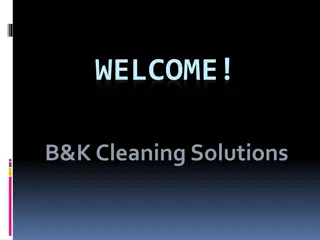Understanding Sterilization in Dental Instrument Cleaning
Sterilization in dental care is crucial for preventing infections and ensuring patient safety. This article explains the processes of sterilization and disinfection, categorizes dental instruments based on infection risk, outlines instrument cleaning methods, and details accepted sterilization techniques like steam pressure, chemical vapor, and dry heat. Proper sterilization is essential for maintaining a clean and safe dental environment.
Download Presentation

Please find below an Image/Link to download the presentation.
The content on the website is provided AS IS for your information and personal use only. It may not be sold, licensed, or shared on other websites without obtaining consent from the author. Download presentation by click this link. If you encounter any issues during the download, it is possible that the publisher has removed the file from their server.
E N D
Presentation Transcript
Sterilization Sterilization Dr. farah
sterilization Sterilization: Is a term referring to any process that eliminates (removes) or kills all forms of microbial life (such as fungi, bacteria, viruses, spores form). Disinfection: Process of destruction or removal of organism, capable of giving rise to infection. These are capable of killing (vegetative bacteria, fungi, viruses) and less effect on resistant bacteria spores.
According to the centers for disease control dental insruments classified into 3 categories depend upon their risk for transmitting infection: 1-critical: penetrate oral soft tissue Bone ,blood sream. Forceps, scalpels, bone chisels, surgical burs. Sterilized after each use Steam under pressure, dry Heat or chemical sterilization 2- semi critical: not penetrate oral tissue In contact oral mucous membrane Non intact skin Dental mirror, amalgam condensor, impression tray. Sterilized after each use. Or high level disinfictant 3- non critical: contact intact skin, m. membrane. X-ray head, pulse oximeter. Cleaned by low level disinfectant.
Instrument cleaning Before sterilization or high-level disinfection, instruments should be cleaned thoroughly to remove debris. Persons involved in cleaning and reprocessing instruments should wear heavy- duty (reusable utility) gloves to lessen the risk of hand injuries. Placing instruments into a container of water or disinfectant/detergent as soon as possible after use will prevent drying of patient material and make cleaning easier and more efficient.
Accepted methods of sterilization : 1. Steam pressure sterilization (auto clave) 2. Chemical vapor pressure sterilization (chemi- clave) 3. Dry heat sterilization (dry clave) 4. Ethylene oxide sterilization 5. Hydrogen Peroxide Plasma
1- Steam under pressure (autoclave) Most effective Most commonly used Get ride of all types of microbes & spores. For a light load of instruments ,250 F (121 C) is a minimum of 15 minutes at 15 lbs pressure. for sterilizing cloth surgical packs and towel packs. handle trays and paper- bagged instruments.
2- Chemical vapor pressure (chemi-clave) 270 F (131 C) and 20 lbs pressure, 20 min. used with chemical: alcohols, Ketones, formaldehyde. Heated under pressure form sterilization gas Carbon steel corrosion-sensitive instruments, and pliers. Towels and wrappings instruments penetrated to sterilization. a prescribed and other burs, heavy of may cloth surgical not provide be
3- Dry heat (oven) Not able to completely kill all microbes. 320 F(160 C) for only 30 achieve sterilization. Inst. Not burnt Glass slab, powders. Carbon steel and burs corrode, or lose their temper or cutting edges if they are well dried before processing. Rapid cycles are possible at high temperatures. temperature minutes to instruments not do rust,
4- Ethylene Oxide Sterilization Ethylene oxide sterilization is the gentlest method for sterilizing complex instruments and delicate materials. Automatic devices sterilize items in several hours and operate at temperatures below100 C. Porous and plastic materials absorb the gas and require aeration for 24 hours or more before it is safe for them to remain in contact with skin or tissues.
5- Hydrogen peroxide plasma to sterilize temperature- sensitive equipment. sterilization cycles of the Sterrad 50 and Sterrad 100 are 45 minutes and 72minutes. respectively. Sterrad 100 Sterrad 50
New Methods of Sterilization Various new methods of sterilization are under investigation and development. 1. -The microwave oven has major limitations for sterilizing metal items without damaging the machine and reaching all sides of the instruments. 2. -Use of peroxide vapor sterilization is under development. 3. -Ultraviolet light is not highly effective against RNA viruses such as HIV and is not very effective against bacterial spores.
Vaccines for Dental Health-Care Workers vaccinated for HBV Vaccination against influenza [H5N1 influenza virus' (bird flu virus), H1N1influanza virus (swine fluvirus), measles, mumps, rubella, and tetanus.
Cleaning And Disinfection Of Dental Unit And Environmental surfaces be cleaned with disposable toweling, using an appropriate cleaning agent and water. Then disinfected: phenolics, iodophors, and chlorine-containing compounds, sodium hypochlorite.
Use and Care of Handpieces and Other Intraoral Dental Devices Attached To Air and Water Lines of Dental Unite sterilization /steam under pressure {autoclaving}, dry heat, or heat/chemical vapor. Manufacturers' instructions for cleaning, lubrication, and sterilization procedures should be followed. ultrasonic scaler tips and air/water syringe tips -- should be cleaned and sterilized after treatment of each patient in the same manner as handpieces. handles or dental unit attachments of saliva ejectors, high-speed air evacuators, and air/water syringes. These components should be covered with impervious barriers changed after each use.
Disposal of Waste Materials Blood, suctioned fluids, or other liquid waste may be poured carefully into a drain connected to a sanitary sewer system. Disposable needles, scalpels, or other sharp items should be placed intact into puncture- resistant containers before disposal. Solid waste contaminated with blood or other body fluids should be placed in sealed, sturdy impervious bags to prevent leakage of the contained.























